Aspioti-ELKA
Aspioti-ELKA (Greek: Ασπιώτη-ΕΛΚΑ) was one of the largest publishing and printing enterprises of Greece.[1] Founded in 1873 in Corfu by Gerasimos Aspiotis as a factory manufacturing playing cards under the name Elpis it eventually merged with the Etairia Lithographias kai Kytiopoieias Athenon (ELKA) and finally became Aspioti-ELKA.[2][3]
 | |
| Headquarters | , |
|---|---|
| Products | Playing cards |
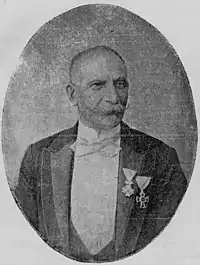
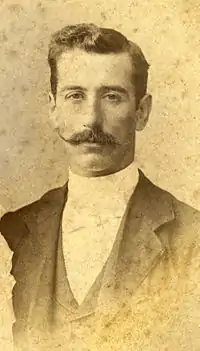

In business for over a century, Aspioti-ELKA was the oldest company of its kind in Greece when it folded in 1997.[1][4] During the post-WWII period Aspioti-ELKA was one of the largest employers in the printing and publishing business in Greece up to 1985.[1] In 1992 the company was sold by the National Bank of Greece to Jean Jacques Lesueur and in October 1997 it was declared bankrupt.[5]
History
In 1873, Gerasimos Aspiotis founded a playing-card factory in Corfu under the name Elpis (Hope).[6] In 1884, Aspiotis secured a contract with the government of Charilaos Trikoupis as the sole manufacturer of playing cards for Greece.[2][3][6] The cards were designed by Gerasimos Aspiotis' father Nikolaos Aspiotis who was a painter.[7]
In 1902 Konstantinos Aspiotis, son of Gerasimos, became the director of the company.[2] Under the directorship of Konstaninos Aspiotis the company product line expanded to include the printing of bonds, shares, advertisements, tickets and other similar products.[2][3]
After the Balkan Wars and the subsequent expansion of Greek lands, the company increased its market share in an expanded internal market. Sales of its popular playing cards increased significantly and so did the company profits.[6]
In 1935 Liakos Iliopoulos became the director of the company and presided over further expansion which lasted until 1940.[2][3][6]
On 28 October 1940, the starting date of the Greco-Italian War, the Italian Air force bombed and destroyed the Aspioti-ELKA factory in Corfu.[6] On that same day the Greek Government, after a lengthy delay of many months, granted Aspioti-ELKA permission to move its machinery and equipment from the Corfu factory to its Athens plant. The machinery moving permit came one day too late as the plant including the machinery now laid in ruins.[6]
The National Bank of Greece keeps a large collection of the company material assets which were manufactured or acquired throughout its history. The bank collection includes stamps, banknotes, advertisements, architectural drawings, financial and statistical tables, an extensive collection of old machinery and other items.[2][3]
References
- University of Minnesota. Modern Greek Studies Program (1995). Modern Greek studies yearbook. University of Minnesota.
- "Αρχείο Εταιρείας Γραφικών Τεχνών Ασπιώτη-ΕΛΚΑ Α.Ε. (1884–1987), Κωδ. Α23 in Greek". National Bank of Greece. Archived from the original on 1 June 2011. Retrieved 13 April 2012.
- "Aspiotis-ELKA Graphic Arts SA (1884–1987), Code A23 in English". National Bank of Greece. Archived from the original on 4 March 2016. Retrieved 13 April 2012.
- "Από τη λεηλασία στην πτώχευση". Rizospastis. 9 November 1997. Archived from the original on 17 February 2013.
Η λεηλασία που υπέστη η εταιρία γραφικών τεχνών – η παλαιότερη του είδους στη χώρα (Google trans: The looting suffered by the graphic arts company – the oldest of its kind in the country)
- "Συγκεντροποίηση και ανατροπές". Rizospastis. 29 January 1999. Archived from the original on 17 February 2013.
Ο Γάλλος ιδιοκτήτης της, Ζαν Ζακ Λεσουέρ – την είχε πάρει χαριστικά το '92 από την Εθνική Τράπεζα – την οδήγησε σε πτώχευση τον Οκτώβρη του '97
- Χατζίδης, Κώστας (31 December 2000). "Κερκυραϊκός εξελληνισμός". tovima.gr.
Το πρωί της 28ης Οκτωβρίου 1940 οι Ιταλοί βομβάρδιζαν την Κέρκυρα. Και το εργοστάσιο της Ασπιώτη – ΕΛΚΑ σωριαζόταν σε σωρούς ερειπίων. Μάταια επί μήνες οι υπεύθυνοι της εταιρείας είχαν προσπαθήσει να λάβουν την άδεια από το κράτος για τη μεταφορά του μηχανικού εξοπλισμού του κερκυραϊκού εργοστασίου στο νέο σύγχρονο εργοστάσιο της Αθήνας στην οδό Φιλαδελφείας. Οι αρμόδιες αρχές είχαν πεισματικά αρνηθεί να επιτρέψουν τη μεταφορά. Και όταν τέλος η άρνησή τους εκάμφθη, ήταν πολύ αργά. Η άδεια χορηγήθηκε την 28η Οκτωβρίου, την ημέρα που άρχιζε ο πόλεμος και το εργοστάσιο καταστρεφόταν από τις φασιστικές αεροπορικές επιδρομές. Google Translation: On the morning of 28 October 1940 the Italians bombarded Corfu. And the factory Aspiotis – ELKA collapsing into piles of rubble. In vain for months the company executives had tried to obtain permission from the government for the transfer of machinery factory of Corfu in the new modern factory in Athens Street Philadelphia. The competent authorities have stubbornly refused to allow the transfer. And when finally the refusal ekamfthi was too late. The license was granted on 28 October, the day the war started and the factory was destroyed by the fascist air raids.
- "ΟΙ ΑΣΠΙΩΤΗΔΕΣ: Mέρος 1ον ΓΕΡΑΣΙΜΟΣ ΑΣΠΙΩΤΗΣ". corfu-museum.gr. Archived from the original on 4 March 2016. Retrieved 13 April 2012.
Gallery
The following images are a small sample of postcards printed in three colour lithography by Aspiotis in Corfu, Greece.
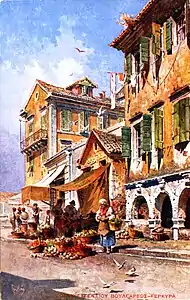 Market place, Corfu (c.1910)
Market place, Corfu (c.1910)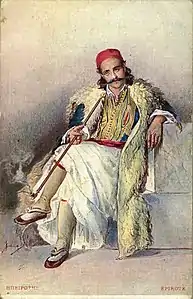 Epirot (c.1910)
Epirot (c.1910) Peasant girl from Mesi, Corfu (c.1910)
Peasant girl from Mesi, Corfu (c.1910) Mauritanian bath (c.1910)
Mauritanian bath (c.1910)
 Parthenon of Athens (c.1910)
Parthenon of Athens (c.1910) Theseion, Athens (c.1910)
Theseion, Athens (c.1910) Sea walls, Corfu (c.1910)
Sea walls, Corfu (c.1910)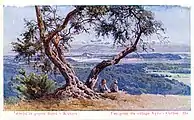 View of Corfu from Viro (c.1910)
View of Corfu from Viro (c.1910)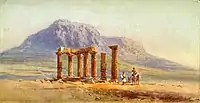 Temple of Zeus, Corinth (c 1910)
Temple of Zeus, Corinth (c 1910)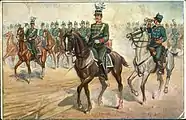 Greek Cavalry (c.1910)
Greek Cavalry (c.1910)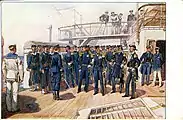 Greek Navy (c.1910)
Greek Navy (c.1910) View of Meteora (c.1910)
View of Meteora (c.1910) Having a rest (c.1910)
Having a rest (c.1910)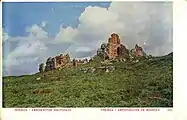 Nicopolis' theatre, Preveza (c.1913)
Nicopolis' theatre, Preveza (c.1913)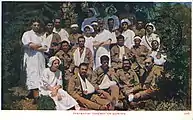 War-injured in Corfu (c.1913)
War-injured in Corfu (c.1913)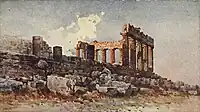 The Parthenon, sunset (c.1920)
The Parthenon, sunset (c.1920)